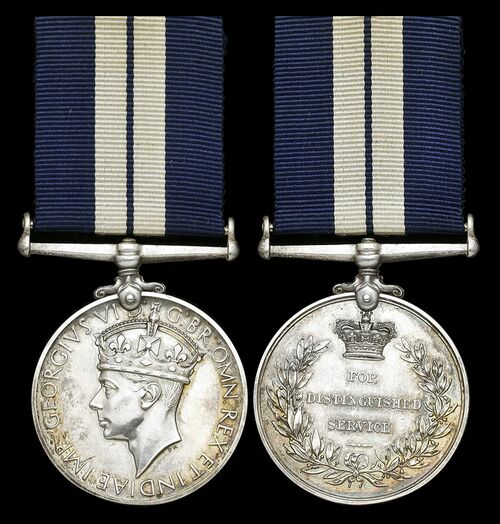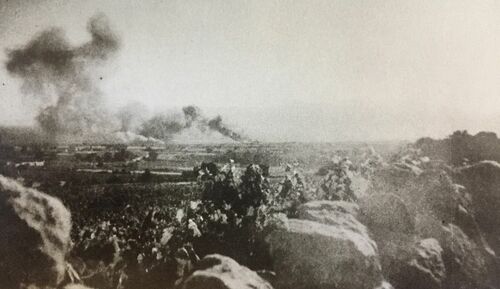Auction: 23003 - Orders, Decorations and Medals
Lot: 236
'At Maleme, the attacking aircraft had avoided the runway on purpose. The dispersal tent with deck-chairs outside had been slashed and riddled by the bullets of strafing fighters, and the perimeter had been bombed, leaving large clouds of dust hanging in the still air. This prevented many of the New Zealanders in the trenches round the airfield from seeing the gliders sweep over to land in and around the bed of the Tavronitis … '
Anthony Beevor's Crete - The Battle and The Resistance, sets the scene at Maleme on the morning of the German airborne invasion on 20 May 1941.
'The noise was indescribable. The ground shuddered under us … our eyes and mouths were full of grit. We were shaken till our teeth felt loose and we could hardly see. Debris continued to crash around us and the sides of our trench crumbled. We lost count of time ….'
Squadron Leader Howells recalls the second major raid on Maleme airfield on the day of the German airborne invasion; Alfie's War, by Richard Pike, refers.
A rare fall of Crete immediate D.S.M. awarded to Chief Petty Officer T. Hall, Royal Navy, attached No. 805 Squadron, Fleet Air Arm
Having endured relentless enemy aircraft attacks on Maleme airfield over previous weeks, he and his comrades faced the full fury of the German airborne invasion on 20 May 1941
Not a few of them were mercilessly shot out of hand as they emerged from slit trenches to surrender but C.P.O. Hall nonetheless chose to return to the airfield's camp to collect vital rations, a gallant enterprise undertaken over open ground in the face of heavy machine-gun fire: indeed his 'courage and morale were excellent' throughout the ensuing days of the bitter battle
Distinguished Service Medal, G.VI.R. (D/J. 2937 T. Hall, C.P.O., R.N.), officially impressed naming, in case of issue, minor official corrections, extremely fine
D.S.M. London Gazette 8 January 1942:
'For outstanding gallantry, fortitude and resolution in the battle of Crete.'
The original recommendation states:
'After the Fleet Air Arm and Royal Air Force personnel were forced by weight of numbers and the superior armament of the enemy to retire from Maleme aerodrome, Chief Petty Officer Hall returned to the camp across open ground under heavy machine-gun fire to obtain rations for his men.
This C.P.O.'s courage and morale throughout the days of the battle were excellent and were a fine example to other men.' (TNA ADM 116/4449, refers).
Thomas Hall was born in Manchester, Lancashire on 27 December 1896 and entered the Royal Navy as a Boy 2nd Class in January 1913.
Baptism of fire
He subsequently witnessed extensive action in the Dardanelles, having joined the battleship H.M.S. Agamemnon in February 1915: in the following month she was damaged by heavy calibre Turkish shellfire on three separate occasions.
Nonetheless, she remained on station and lent support to the Gallipoli landings in late April, Hall's service record noting that he was posted missing on 3 May 1915. This suggests that he was landed on the peninsula to spot for Agamemnon's gunfire, a contention supported by his service record which notes a bullet wound to the back of his right leg; two days later he was reported as being embarked for hospital treatment.
On recovering from his wound, Hall returned to duty in the Agamemnon, followed by further active service in the light cruiser Cambrian from July 1917 until the end of the war.
Having then been awarded the L.S. & G.C. Medal in 1930 and been pensioned ashore as a Chief Petty Officer in 1936, he was mobilised on the renewal of hostilities and joined Grebe, the Fleet Air Arm base in the Middle East, in December 1940.
Battle of Crete
As verified by his service record, he was subsequently attached to the strength of No. 805 Squadron, and it was in this capacity that he was awarded his D.S.M., for the squadron was ordered to the defence of Crete in early 1941.
Based at Maleme airfield, 805 Squadron was subjected to constant air raids in the lead up to the German airborne invasion on 20 May, suffering significant losses in personnel and aircraft. In fact, by the eve of the German airborne invasion, its few remaining Fulmars and Brewsters were grounded due to lack of spares.
Nonetheless, C.P.O. Hall and his fellow Fleet Air Arm personnel co-existed happily alongside their R.A.F. counterparts at Maleme, where a ship's bell serving as an air raid warning hung outside the dispersal tent, a well-worn bell on account of the incessant raids mounted against the airfield's defences throughout May.
On the morning of the German airborne invasion on the 20th, those manning the airfield's Bofors guns - mainly gallant Kiwis of the 22nd Battalion - readied themselves for the coming onslaught. Anthony Beevor's Crete - The Battle and The Resistance, takes up the story:
'Just before eight o'clock the sound of heavy engines was heard: 'an angry throb'. Communications were so ineffectual that warning of this enemy force, which had been picked up well in advance by the radar station on a hill a few kilometres to the rear of Maleme, had not arrived from Western's air defence centre at Suda Bay. The ship's bell hanging outside the dispersal tent was now rung vigorously again to the sound of the alarm.
This second wave from Richthofen's VIII Air Corps consisted of twin-engined bombers, Dornier 17s and Junkers 88s, followed by strafing fighters. There was a mad rush for the slit trenches under tamarisk and olive trees on the edge of the airfield. Once again the Bofors gun pits were the main target. Their crews were so badly shaken by these attacks that only one gun returned fire, and then inaccurately. With conspicuous bravery, a medical team drove an ambulance across the runway at the height of the attack to the aid of badly wounded group.
The shock waves from each exploding bomb could be felt like a muffled blow to the stomach, and heads began to ache from the relentless percussion. Much has been written of the effect of the Stuka dive-bomber, whose siren was designed to increase the fear of its victims. Yet for many on Crete, the heart-stopping scream of a Messerschmitt fighter appearing from nowhere at tree-top level was far more terrifying.
Just after the raid finished - one sergeant described the brief silence as 'eerie, acrid and ominous' - strangely shaped aircraft with long tapering wings swept low over the airfield. Those New Zealanders of the 22nd Battalion who saw through the cloud of smoke and dust yelled 'Gliders!' virtually in unison.
As these gliders crossed their field of vision, most of them sweeping in to land on the stoney river-bed of the Tavronitis, the infantrymen in their slit trenches opened up with small arms of every sort. This produced a noise like a mass of fire-crackers set off simultaneously. Several gliders smashed on the stones of the broad, almost dry river-bed, injuring many of their occupants. One bounced off the bridge itself. In a couple of cases, the New Zealanders succeeded in hitting the pilot … '
This picture of early German airborne losses was much enhanced by the fate awaiting Major Scherber's III Battalion, which landed on the Canea side of Maleme airfield. Beevor continues:
'Most of Scherber's men landed on the well-concealed positions of the New Zealand Division's Engineer Detachment and 23rd Battalion. One group dropped on battalion headquarters. Colonel Leckie killed five and his adjutant, seated on a packing case which served as his desk, shot two without standing up.
Exultant cries of 'Got the bastard!' could be heard on all sides. Nowhere was it heard with greater glee than amongst the former inmates of the Field Punishment Centre at Modhion, just inland from the Engineer Detachment. The soldiers under sentence there were given rifles and the promise of a pardon if they fought well, then let off the leash to hunt down paratroopers scattered in their area. Sixty prisoners killed a hundred and ten in less than an hour.
Those Germans who survived the descent through crossfire arrived doubly disorientated by the unexpected resistance. Some crashed on to roofs, others through the branches of olive trees. There they were shot before they had time to wriggle out of their harnesses. Suspended bodies twisted gently as if from macabre gibbets of a previous century.
Even those who landed unwounded and unseen in a vineyard or field of barley could not fight back effectively until they found their weapons. And if a container had fallen in the open, retrieving it was like a murderous game of grandmother's footsteps. Scherber, his adjutant, and three out of four company commanders were killed, along with nearly four hundred men … '
However, at length, the large body of enemy paratroopers who had landed on the Tavronitis river-bed, managed to penetrate between two of the N.Z. 22nd Battalion's companies and overrun the Maleme airfield's camp. Beevor continues:
'Keyed up paratroopers, mostly by instinctive reflex, shot aircraftmen emerging from concealed slit trenches to surrender. One group, however, lined up eight R.A.F. men they found on the surface. Leading Aircraftman Lawrence shouted at them that they had no right to shoot prisoners without the express order of an officer. The German paratroopers were so amazed at the idea of prisoners refusing to be shot that an officer was sent for, and they were spared.
But those made prisoner were by no means safe. Their captors forced them to march forward as a screen towards Hill 107. This manoeuvre ended in a murderous shambles when a New Zealand section tried to take the German paratroopers in the flank and the prisoners, both R.A.F. and Fleet Air Arm personnel, made a run for it with varying degrees of success.
Other fitters and a couple of officers had already pulled back from the airfield past the thickets of bamboo which obscured the airfield from the positions on the hill behind. They joined up with New Zealand companies and some of them fought effectively as infantrymen for the day.'
Hereabouts then, the point at which C.P.O. Thomas Hall rushed across open ground under heavy machine-gun fire to retrieve rations for his men from the camp, just one act of bravery displayed by him over the coming days, when his courage and morale 'were excellent and a fine example to his men.'
It seems likely he had joined a group of Maleme's airfield personnel under Lieutenant A. E. F. Sutton, D.S.C., R.N., for the senior officer, Commander G. H. Beale, R.N., was wounded by a grenade early in the action. A glimpse of Sutton and his men in action on Hill 107, overlooking the airfield, may be found on the BBC's World War II People's War website, an account that credits a Royal Marine braving enemy fire to bring them rations. Given the above recommendation, it seems that reference should apply to C.P.O. Hall, or perhaps both ran the gauntlet.
Hall's ongoing courage and example over the coming days was likely undertaken in a punishing trek over the White Mountains to Sphakia on the south coast, where the Royal Navy carried out the final evacuation of the island.
He was released from naval service 'Class A' in October 1945.
Subject to 20% VAT on Buyer’s Premium. For more information please view Terms and Conditions for Buyers.
Sold for
£950
Starting price
£800







